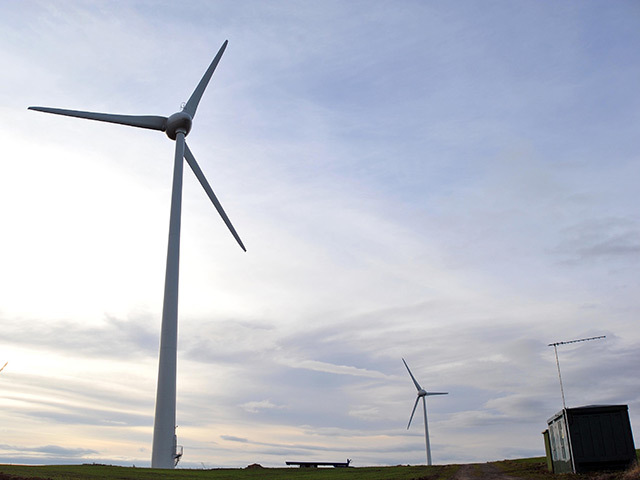
Renewable-energy developers are increasingly selling wind power straight to the users, tapping a new customer base as some traditional utility buyers are backing away.
Technology giants have led the way, including Google’s deal Dec. 3 for 625 megawatts of U.S. wind power and Microsoft Corp.’s biggest-ever wind deal Dec. 1. Other industries are following suit, with businesses, universities, government agencies and other non-utility buyers accounting for 32 percent of U.S. contracts this year through early November, according to the American Wind Energy Association, up from 5 percent for all of 2013.
Three parallel trends are driving the shift. Companies have realized that buying renewable energy from developers is often cheaper than getting power from their local utilities. At the same time, a growing number of utilities have met state renewable-energy mandates and are putting the brakes on new deals. Meanwhile, U.S. wind installations are expected to climb 76 percent this year.
“If utilities in Kansas don’t need power right now, you as a developer either are forced to sit on the project for years or find a different class of buyer,” said Quayle Hodek, chief executive officer of Renewable Choice Energy, a Boulder, Colorado-based consultant that matches Fortune 500 companies with renewable energy projects looking to sell electricity.
New Market
That’s opening up a new market for developers, which typically can’t line up financing for new wind farms until they’ve also lined up long-term buyers for the power.
Companies are creating “a new source of demand,” said Jacob Susman, CEO of OwnEnergy Inc., a New York-based developer of mid-sized wind farms that was acquired by Electricite de France SA in August. OwnEnergy’s customers have included Yahoo! Inc. and Procter & Gamble Co.
Under these deals, a corporate buyer typically signs a long-term contract for the electricity with the developer. The power is delivered through the local grid; rarely is there a direct transmission line from the wind farm itself.
Stability, Savings
For businesses, these contracts provide two main advantages: price and predictability.
“Day one, we’re going to be saving 10 percent over what we’re paying today,” said Rame Hemstreet, chief energy officer at Kaiser Permanente, which has a contract to buy 153 megawatts of wind and solar capacity from NextEra Energy Inc.
Not only are prices lower, they’re often locked in by years-long power-purchase deals.
“We don’t have to wonder what our power prices will be for 20 years,” Rick Needham, Google’s director of green business operations, said in an interview.
While companies are keen to help the environment, it must first make economic sense, said Hodek.
“This is not just for the environment — this can be something to provide long-term cost stability,” he said. “Companies are saying, ‘What am I missing out on? Let’s do this,’ ” he said.
Utility Demand
At the same time, demand from some utilities is slowing.
Most states are on track to meet renewable portfolio standards, policies that require utilities to source a certain percentage of their power from clean sources, and five already have, according to Susan Sloan, vice president of state policy at AWEA.
That’s not slowing wind installations, which are expected to reach 9 gigawatts this year in the U.S., up from 5.1 gigawatts in 2014, according to Bloomberg New Energy Finance. That means more developers than ever are seeking power-purchase agreements.
“There’s a shortage of PPAs in part because there’s never been so much power under development,” said Amy Grace, North American wind analyst with New Energy Finance.
Data Centers
Technology companies including Google were some of the first movers, often to run power-hungry data centers. The Alphabet Inc. company has signed deals for about 2 gigawatts of clean energy worldwide since 2010. Including the five contracts the company announced Dec. 3, it has deals for more than 1.3 gigawatts of wind power in the U.S and Sweden. Facebook Inc. and Apple Inc. have also made significant purchases of clean energy.
That’s spreading to other other industries.
“The trend is extending beyond tech companies, which are the usual adopters,” said Hannah Hunt, a research analyst at AWEA. Non-utility buyers have purchased more than 800 megawatts of wind power this year.
Owens Corning, a supplier of building materials and other industrial products, announced Nov. 13 a deal to purchase 125 megawatts from a wind farm under development in Texas. Dow Chemical Co., the U.S. General Services Administration, and Ohio State University have also struck deals to buy wind power from developers instead of utilities.
“The market is a lot smaller without non-utility customers,” Travis Bryan, chief operating officer at Seattle- based developer OneEnergy Renewables, said in an e-mail. “In certain markets like New York and Massachusetts, non-utility customers have been absolutely critical and will likely continue to remain so going forward.”
Recommended for you
